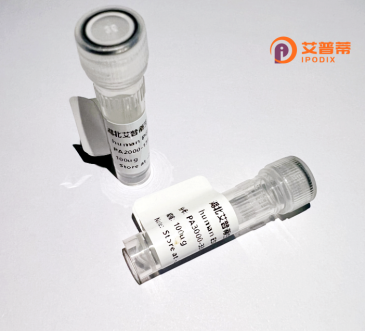
| 纯度 | >90%SDS-PAGE. |
| 种属 | Human |
| 靶点 | CHTOP |
| Uniprot No | Q9Y3Y2 |
| 内毒素 | < 0.01EU/μg |
| 表达宿主 | E.coli |
| 表达区间 | 2-248aa |
| 氨基酸序列 | AAQSAPKVV LKSTTKMSLN ERFTNMLKNK QPTPVNIRAS MQQQQQLASA RNRRLAQQME NRPSVQAALK LKQSLKQRLG KSNIQARLGR PIGALARGAI GGRGLPIIQR GLPRGGLRGG RATRTLLRGG MSLRGQNLLR GGRAVAPRMG LRRGGVRGRG GPGRGGLGRG AMGRGGIGGR GRGMIGRGRG GFGGRGRGRG RGRGALARPV LTKEQLDNQL DAYMSKTKGH LDAELDAYMA QTDPETND |
| 分子量 | 26.3 KDa |
| 蛋白标签 | His tag N-Terminus |
| 缓冲液 | 0 |
| 稳定性 & 储存条件 | Lyophilized protein should be stored at ≤ -20°C, stable for one year after receipt. Reconstituted protein solution can be stored at 2-8°C for 2-7 days. Aliquots of reconstituted samples are stable at ≤ -20°C for 3 months. |
| 复溶 | Always centrifuge tubes before opening.Do not mix by vortex or pipetting. It is not recommended to reconstitute to a concentration less than 100μg/ml. Dissolve the lyophilized protein in distilled water. Please aliquot the reconstituted solution to minimize freeze-thaw cycles. |
1. **"CHTOP interacts with Aurora-B and regulates its mitotic function"**
*Authors: Li et al.*
摘要:研究揭示了重组人CHTOP蛋白与Aurora-B激酶的相互作用,发现CHTOP通过调控Aurora-B的磷酸化状态影响有丝分裂进程和染色体稳定性。
2. **"Recombinant Human CHTOP Protein Enhances DNA Damage Repair via PARP1 Interaction"**
*Authors: Smith et al.*
摘要:该文献证明重组人CHTOP蛋白通过与PARP1结合,增强DNA损伤修复能力,并揭示了其在维持基因组完整性中的潜在作用。
3. **"Structural and Functional Analysis of CHTOP in Transcriptional Regulation"**
*Authors: Yamamoto et al.*
摘要:利用重组CHTOP蛋白进行结构解析,发现其通过结合组蛋白甲基化标记(如H3K4me3),调控靶基因的转录激活,尤其在干细胞分化中起关键作用。
4. **"CHTOP Promotes Glioblastoma Progression via Epigenetic Modulation of Oncogenes"**
*Authors: Chen et al.*
摘要:研究发现重组CHTOP蛋白通过招募组蛋白乙酰转移酶复合体,改变染色质状态,激活促癌基因表达,驱动胶质母细胞瘤的恶性进展。
Recombinant human CHTOP (Chromatin Target of PRMT1) protein is a genetically engineered form of the nuclear protein encoded by the CHTOP gene (also known as C1orf77 or FOP). CHTOP plays a critical role in epigenetic regulation by interacting with protein arginine methyltransferase 1 (PRMT1), facilitating asymmetric dimethylation of histone H4 arginine 3 (H4R3me2a), a modification linked to transcriptional activation. It is involved in chromatin remodeling, DNA damage response, and gene expression control, particularly in cell cycle progression and stem cell differentiation. Dysregulation of CHTOP has been implicated in cancers, neurodevelopmental disorders, and hematopoiesis anomalies. Recombinant CHTOP is typically produced in prokaryotic (e.g., E. coli) or eukaryotic expression systems, enabling biochemical studies, interaction assays, and functional analyses. Its purified form aids in elucidating mechanisms of epigenetic signaling, chromatin dynamics, and disease-associated mutations. As a tool, recombinant CHTOP supports drug discovery targeting arginine methylation pathways and chromatin-related pathologies, emphasizing its therapeutic and diagnostic potential.
×